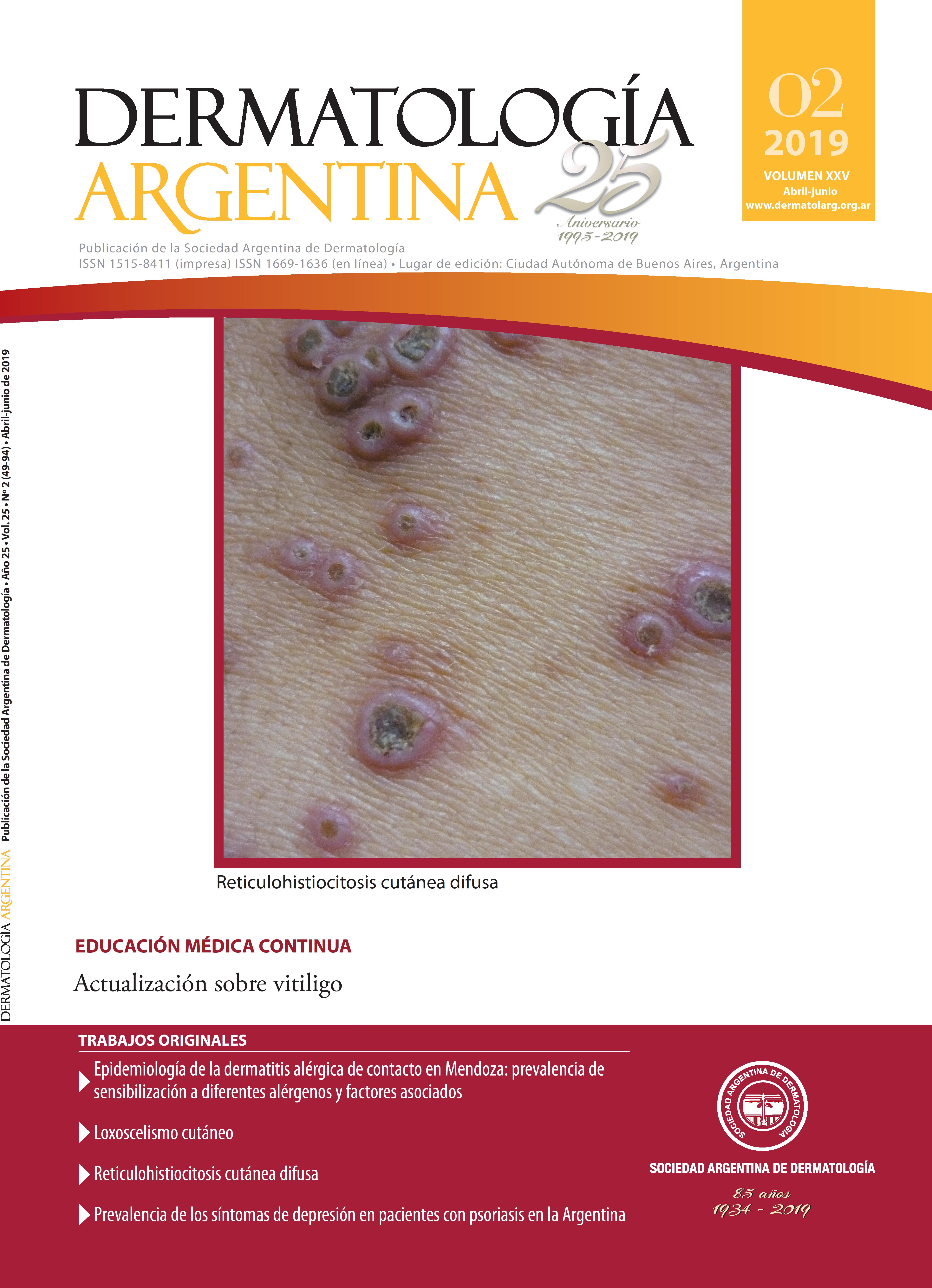Epidemiology of allergic contact dermatitis in Mendoza: prevalence of sensitization to different allergens and associated factors
Keywords:
allergens, allergic contact dermatitis, patch testAbstract
Background: allergic contact dermatitis (ACD) is one of the most common dermatological disorders in the world that can cause several degrees of morbidity and decrease the quality of life.
Objective: to study the epidemiological characteristics and prevalence of sensitization to different allergens in L. C. Lagomaggiore´s Hospital.
Design: a descriptive, retrospective, observational and cross-sectional study was performed.
Methods: patients with a history of chronic eczema were evaluated in L. C. Lagomaggiore’s Hospital from March 2017 to March 2018. A specific medical history and patch test were performed using the standard Latin American battery of 40 allergens.
Results: a total of 74 patients were evaluated. 77% (n: 56) were women. The mean age was 42 years (SD 15). Patch Test was positive in 82.4% (n: 61). Nickel was the most prevalent allergen (45.9%, n: 34), followed by palladium (41.9%, n: 31) and methylisothiazolinone (MI) (31.1% n: 23). Hands were the most frequent location (64.8%). This is related to the high frequency of hand washing and positive patch test to MI (OR 2.6; p = 0.048 and OR 3.6; p = 0.038 respectively). Women had higher sensitivity to Nickel than men (OR 5.5; p = 0.0115).
Conclusions: in our study, we have found that the most affected sex, the prevalent allergens and the involved site are the same of the literature. We highlight MI as the third most common allergen in our community. This shows that MI sensitization has increased worldwide in recent years.
Key words: allergens, allergic contact dermatitis, patch test.
References
I. Alikhan A, Maibach HI. Allergic contact dermatitis. Chem Immunol Allergy 2014;100:97-100.
II. La Forgia M, Cannavó A, Fotunato L, Infante L, et ál. Consenso de Dermatitis por Contacto 2015. Sociedad Argentina de Dermatología. Disponible en: http://www.sad.org.ar/wp-content/ uploads/2016/04/consenso-dermatitis-por-contacto-2015.pdf
III. Bourke J, Coulson I, English J, British Association of Dermatologists Therapy Guidelines and Audit Subcommittee. Guidelines for the management of contact dermatitis: an update. Br J Dermatol 2009;160:946-954.
IV. Gutiérrez Terrazas, T, Ocampo Candiani, J, Gomez Flores M, Herz Ruelas M. Estudio de la dermatitis por contacto alérgica mediante pruebas del parche, serie estándar europea en el Departamento de Dermatología del Hospital Universitario Dr. José Eleuterio González, UANL. Dermatol Cosmética Médica Quirúrgica 2008;6:15-23.
V. Bordel-Gómez MT, Miranda-Romero A, Castrodeza-Sanz J. Epidemiology of contact dermatitis: prevalence of sensitization to different allergens and associated factors. Actas Dermosifiliogr 2010;101:59-75.
VI. Wolf R, Orion E, Ruocco V, Baroni A, et ál. Patch testing: facts and controversies. Clin Dermatol 2013;31:479-486.
VII. Rui F, Bovenzi M, Prodi A, Belloni Fortina A, et ál. Nickel, chromium and cobalt sensitization in a patch test population in north-eastern Italy (1996-2010). Contact Dermatitis 2013;68:23-31.
VIII. Russo JP, Cannavó AB, La Forgia MP, Kvitko E, et ál. Dermatitis de contacto por metilisotiazolinona: prevalencia en seis centros de atención especializada durante los años 2014 y 2015. Dermatol Argent 2017;23:117-122.
IX. Fonacier L. A Practical Guide to Patch Testing. J Allergy Clin Immunol Pract 2015;3:669-675.
X. Owen JL, Vakharia PP, Silverberg JI. The role and diagnosis of allergic contact dermatitis in patients with atopic dermatitis. Am J Clin Dermatol 2018;19:293-302.
XI. Hamann CR, Hamann D, Egeberg A, Johansen JD, et ál. Association between atopic dermatitis and contact sensitization: A systematic review and meta-analysis. J Am Acad Dermatol 2017;77:70-78.
XII. Aguilar-Bernier M, Bernal-Ruiz AI, Rivas-Ruiz F, Fernández-Morano MT, et ál. Contact sensitization to allergens in the Spanish standard series at Hospital Costa del Sol in Marbella, Spain: a retrospective study (2005-2010). Actas Dermosifiliogr 2012;103:223-228.
XIII. Uter W, Hegewald J, Aberer W, Ayala F, et ál. The European standard series in 9 European countries, 2002/2003. First results of the European Surveillance System on Contact Allergies. Contact Dermatitis 2005;53:136-145.
XIV. Akyol A, Boyvat A, Peksari Y, Gürgey E. Contact sensitivity to standard series allergens in 1038 patients with contact dermatitis in Turkey. Contact Dermatitis 2005;52:333-337.
XV. Schram SE, Warshaw EM. Genetics of nickel allergic contact dermatitis. Dermatitis 2007;18:125-33.
XVI. Dotterud LK, Smith-Sivertsen T. Allergic contact sensitization in the general adult population: a population-based study from Northern Norway. Contact Dermatitis 2007;56:10-15.
XVII. Schuttelaar MLA, Ofenloch RF, Bruze M, Cazzaniga S, et ál. Prevalence of contact allergy to metals in the European general population with a focus on nickel and piercings: The EDEN Fragrance Study. Contact Dermatitis 2018;79:1-9.
XVIII. Duarte I, Mendonça RF, Korkes KL, Lazzarini R, et ál. Nickel, chromium and cobalt: the relevant allergens in allergic contact dermatitis. Comparative study between two periods: 1995-2002 and 2003-2015. An Bras Dermatol 2018;93:59-62.
XIX. Muris J, Goossens A, Gonçalo M, Bircher AJ, et ál. Sensitization to palladium and nickel in Europe and the relationship with oral disease and dental alloys. Contact Dermatitis 2015;72:286-296.
XX. Chow M, Botto N, Maibach H. Allergic contact dermatitis caused by palladium-containing dental implants. Dermatitis 2014;25:273-274.
XXI. De Unamuno B, Zaragoza Ninet V, Sierra C, De la Cuadra J. Descriptive study of sensitization to methylchloroisothiazolinone and methylisothiazolinone in a skin allergy unit. Actas Dermosifiliogr 2014;105:854-859.
Downloads
Published
Issue
Section
License
El/los autor/es tranfieren todos los derechos de autor del manuscrito arriba mencionado a Dermatología Argentina en el caso de que el trabajo sea publicado. El/los autor/es declaran que el artículo es original, que no infringe ningún derecho de propiedad intelectual u otros derechos de terceros, que no se encuentra bajo consideración de otra revista y que no ha sido previamente publicado.
Le solicitamos haga click aquí para imprimir, firmar y enviar por correo postal la transferencia de los derechos de autor












